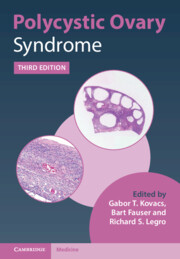Book contents
- Polycystic Ovary Syndrome
- Polycystic Ovary Syndrome
- Copyright page
- Contents
- Contributors
- Chapter 1 Introduction to and History of Polycystic Ovary Syndrome
- Chapter 2 Polycystic Ovary Syndrome: From Phenotype to Genotype
- Chapter 3 The Epidemiology of Polycystic Ovary Syndrome
- Chapter 4 Ovarian Ultrasonography in Polycystic Ovary Syndrome
- Chapter 5 The Classification of Polycystic Ovary Syndrome Informed by the International Guideline 2018
- Chapter 6 The Relevance of the Anti-Müllerian Hormone in Polycystic Ovary Syndrome Diagnosis and Management
- Chapter 7 Origins of Polycystic Ovary Syndrome In Utero
- Chapter 8 Adrenal and Polycystic Ovary Syndrome
- Chapter 9 Polycystic Ovary Syndrome and Environmental Toxins
- Chapter 10 Lifestyle in Polycystic Ovary Syndrome
- Chapter 11 Ovulation Induction in Polycystic Ovary Syndrome
- Chapter 12 Ovarian Surgery for Ovulation Induction
- Chapter 13 In Vitro Fertilization and Assisted Reproductive Technologies in Polycystic Ovary Syndrome
- Chapter 14 Pregnancy Complications and Children Outcomes in Patients with Polycystic Ovarian Syndrome
- Chapter 15 The Role of In Vitro Maturation in Polycystic Ovary Syndrome
- Chapter 16 The Treatment of Obesity in Polycystic Ovary Syndrome
- Chapter 17 Mood Disorders in Polycystic Ovary Syndrome
- Chapter 18 The Long-Term Health Consequences of Polycystic Ovary Syndrome
- Chapter 19 Polycystic Ovary Syndrome
- Chapter 20 Cancer and Polycystic Ovary Syndrome
- Index
- References
Chapter 1 - Introduction to and History of Polycystic Ovary Syndrome
Published online by Cambridge University Press: 13 May 2022
- Polycystic Ovary Syndrome
- Polycystic Ovary Syndrome
- Copyright page
- Contents
- Contributors
- Chapter 1 Introduction to and History of Polycystic Ovary Syndrome
- Chapter 2 Polycystic Ovary Syndrome: From Phenotype to Genotype
- Chapter 3 The Epidemiology of Polycystic Ovary Syndrome
- Chapter 4 Ovarian Ultrasonography in Polycystic Ovary Syndrome
- Chapter 5 The Classification of Polycystic Ovary Syndrome Informed by the International Guideline 2018
- Chapter 6 The Relevance of the Anti-Müllerian Hormone in Polycystic Ovary Syndrome Diagnosis and Management
- Chapter 7 Origins of Polycystic Ovary Syndrome In Utero
- Chapter 8 Adrenal and Polycystic Ovary Syndrome
- Chapter 9 Polycystic Ovary Syndrome and Environmental Toxins
- Chapter 10 Lifestyle in Polycystic Ovary Syndrome
- Chapter 11 Ovulation Induction in Polycystic Ovary Syndrome
- Chapter 12 Ovarian Surgery for Ovulation Induction
- Chapter 13 In Vitro Fertilization and Assisted Reproductive Technologies in Polycystic Ovary Syndrome
- Chapter 14 Pregnancy Complications and Children Outcomes in Patients with Polycystic Ovarian Syndrome
- Chapter 15 The Role of In Vitro Maturation in Polycystic Ovary Syndrome
- Chapter 16 The Treatment of Obesity in Polycystic Ovary Syndrome
- Chapter 17 Mood Disorders in Polycystic Ovary Syndrome
- Chapter 18 The Long-Term Health Consequences of Polycystic Ovary Syndrome
- Chapter 19 Polycystic Ovary Syndrome
- Chapter 20 Cancer and Polycystic Ovary Syndrome
- Index
- References
Summary
Although the modern history of polycystic ovary syndrome (PCOS) started with the pivotal paper by Stein and Leventhal in 1935,[1] there are suggestions that the “syndrome” was referred to as early as in the time of Hippocrates (ca. 460–377 BC). Medical notes at the time referred to women “whose menstruation is less than three days or is meager, are robust, with a healthy complexion and a masculine appearance; yet they are not concerned about bearing children nor do they become pregnant” and suggest that they may have been describing women with PCOS.[2]
- Type
- Chapter
- Information
- Polycystic Ovary Syndrome , pp. 1 - 7Publisher: Cambridge University PressPrint publication year: 2022
References
- 1
- Cited by



